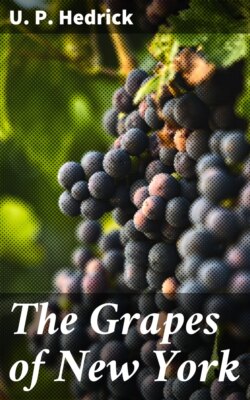Читать книгу The Grapes of New York - U. P. Hedrick - Страница 37
На сайте Литреса книга снята с продажи.
12. VITIS BERLANDIERI Planch.
ОглавлениеTable of Contents
1. Planchon, Compt. Rend. Acad. Sci. Paris, 91:425. 1880. (cited by 5). 2. Journ. La Vigne amer., 1880:318. (cited by 5.) 3. Gar. Mon., 23:25. 1881. V. aestivalis, var. monticola; V. monticola seedling; V. cordifolia coriacea. 4. (?) Engelmann, Bush. Cat., 1883:15. V. monticola. 5. Planchon, De Candolle’s Mon. Phan., 5:323, 341. 1887. V. monticola. 6. An. Hort., 1889:101. 7. Munson, U. S. D. A. Pom. Bul., 3:14. 1890. V. Monticola, Mil. 8. Ib., Gar. and For., 3:474, 475. 1890. 9. Ib., Am. Gard., 12:659. 1891. 10. Ib., Bush. Cat., 1894:20, 22, 29. V. monticola, Engelm. 11. Bailey, Gray’s Syn. Fl., 1:425. 1897. Mountain grape; Spanish grape; Fall grape; Winter grape. 12. Beach, N. Y. Sta. An. Rpt., 17:536, 557. 1898. 13. Munson, Tex. Sta. Bul., 56:231, 234, 235, 240, 261. 1900. fig. Little Mountain grape. 14. Viala and Ravaz, Am. Vines, 1903:42, 61.
Vine moderately vigorous, climbing; shoots more or less angled and pubescent; pubescence remaining only in patches on mature wood; canes mostly with short internodes; diaphragms thick; tendrils intermittent, long, strong, bifid or trifid. Leaves with small stipules; leaf-blade rather large, broadly cordate, notched or shortly three-lobed; petiolar sinus rather open, V- or U-shaped, margin with broad but rather shallow teeth, rather dark, glossy green above, grayish pubescence below when young; becoming glabrous and even glossy except on ribs and veins, when mature. Clusters large, compact, compound, with long peduncle. Berries small, black, with thin bloom, juicy, rather tart but pleasant tasting when thoroughly ripe. Seeds few, medium to small, short, plump, oval or roundish with short beak; chalaza oval or roundish, distinct; raphe narrow, slightly distinct to indistinct. Leafing, flowering and ripening fruit very late.
This species was described under the name Vitis berlandieri by Planchon in 1880. The description was made from herbarium specimens collected by the Swiss botanist, Berlandier,[142] in Texas in 1834, and also from living plants which had been shipped into France. Planchon states that this is the Monticola of Engelmann, but not the Monticola of Buckley. Buckley’s description is admittedly unsatisfactory but it does not seem that Planchon is justified in saying that Engelmann was mistaken when the latter probably had better opportunities for determining Buckley’s meaning than Planchon.
Berlandieri is a native of the limestone hills of southwest Texas and adjacent Mexico. According to Munson, it grows “in the same region with V. monticola but is less restricted locally, growing from the tops of the hills all along down and along the creek bottoms of those regions.” Its great virtue is that it withstands a soil largely composed of lime. It is superior to all other American species in this respect. This and its moderate degree of vigor (not quite so vigorous as Cinerea, according to Munson) has recommended it to the French growers as a stock for their calcareous soils. The roots are strong, thick and very resistant to phylloxera.
It is propagated by cuttings with comparative ease, but its varieties are variable in this respect, some not rooting at all easily. While the fruit of this species shows a large cluster, the berries are small and sour, and Berlandieri is not regarded as having any promise for culture in America.
